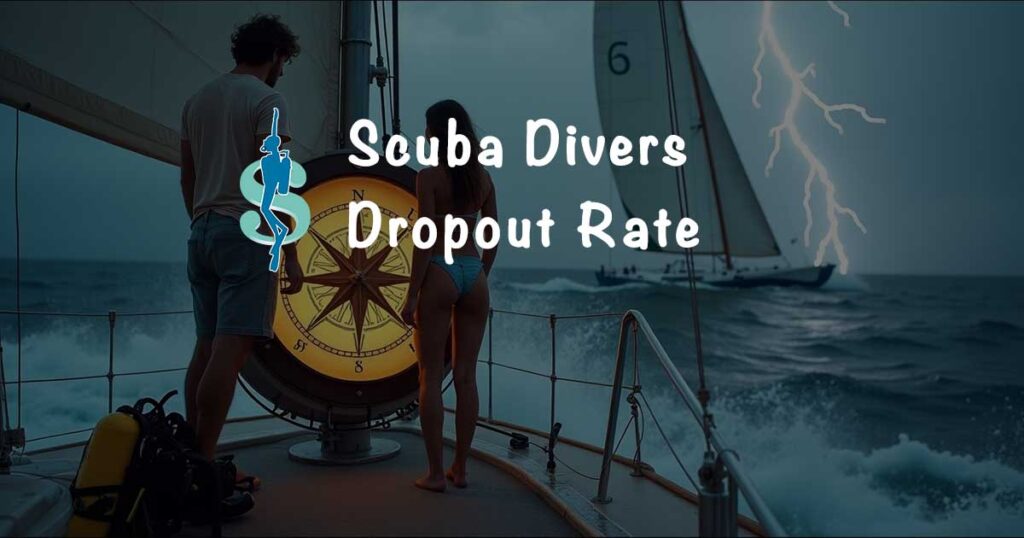Scuba Divers Dropout Rate
Causes and solutions to the high scuba diver dropout rate in the scuba diving industry.
“After basic training in a swimming pool and an open water check-out, the majority of students seldom, if ever, dive again.”
In other words, the scuba diver dropout rate is significant. When do you think the above statement was made? A long time ago, by Bill Barada, when newsletters were prepared with a typewriter. Don Rockwell, the former CEO of Aqua Lung, showed me this newsletter in the museum of scuba diving that Aqualung used to maintain in its upstairs lobby in California.
Let’s shed some light on the much-talked-about ‘scuba divers dropout’ rate in the dive industry.
This post is part of our Dive Industry Compass series by the Business of Diving Institute and Darcy Kieran, author of:
Contents on This Page
TL;DR Overview
For scuba diving industry professionals, the scuba diver dropout rate is a critical, yet largely unquantified, challenge. While precise figures fluctuate by region and dive center, a 1988 DEMA study indicated a dropout rate of approximately 15% one year after entry-level certification, increasing to over 50% after four years.
Alarmingly, despite over 100,000 new certifications annually in the USA, more scuba divers are currently dropping out each year than are being certified, based on the annual participation rate, actively hindering industry growth. This suggests that many new divers, after completing classroom, pool, and open water training, do not feel adequately prepared to truly enjoy the sport, leading them to cease diving.
To reverse this trend, the industry must “dig deeper” to understand the underlying reasons for abandonment by systematically surveying both current and former divers, potentially even during entry-level courses.
Strategic solutions include enhancing quality control and consistency in the dive experience, redesigning dive centers to better meet modern customer expectations, and making underwater exploration more convenient to foster sustained participation.
We dive deeper into the percentage of scuba divers dropping out in a discussion about the disastrous scuba tryouts (discover scuba diving).
1. How many scuba divers drop out?
It’s a million-dollar question. For now, let’s say that we don’t know exactly what the scuba diver dropout rate is. It fluctuates among dive stores and geographical regions, but it’s high. It is probably a little bit less than what Barada was contemplating, though:
“The extent of the dropout problem can be appreciated by the results of a recent survey made by (…) Advanced Sport Divers in Sacramento, California. Their survey of the Sacramento area showed that 99% of new students dropped out of diving in the first year.”
I’m sure (I hope) it’s currently less than 99%!
DEMA Diver Erosion Study
In a 1988 DEMA report titled “DEMA Diver Erosion Study,” it was stated that the scuba diver dropout rate was about 15% one year after entry-level certification, and more than 50% after four years.
The main conclusion was: “The graph and tables appearing below suggest that the 80%, one-year diver drop-out rate referred to in a number of dive industry articles is not accurate.”
The results in that study were confusing, though. The sample consisted of only 347 divers, with no indication of how these divers were recruited for the survey. Were they randomly selected or part of a list of active divers?
Furthermore, something else was strange. Some of the divers who answered the survey had been certified divers for less than two years — yet the study was evaluating their behavior up to 4 years after certification.
Declining Scuba Diving Participation Rate
One reliable source of market data is the Sports & Fitness Industry Association (SFIA), which conducts annual surveys of the American population, including a comprehensive report on scuba diving.
Even though we train more than 100,00o new scuba divers every year in the USA, the scuba diving participation rate keeps dropping. In other words, there are more scuba divers dropping out every year than there are new divers getting certified. It’s not negligible!
Some people will tell you that our dropout rate is “not that bad,” but that is because they calculate it only on the number of new entry-level scuba diving certifications issued. The fact is that people who did a Discover Scuba Diving were also introduced to scuba diving, and if they decide never to dive again, they are dropouts.
From our estimates, if we were to cut our dropout rate by half, the dive industry would be growing by 60% annually!
The outdoor industry is booming. Scuba diving is not. We need to fix this.
We lack a reliable source of information to determine the actual scuba diver dropout rate. Nevertheless, we can estimate that the scuba diver drop-out rate is somewhere between 15% and 99% one year after certification and between 50% and 99% four years after certification.
2. What are we doing about the scuba diver dropout rate?
I recall a DEMA Show from a few years ago. A training agency was focusing its efforts on convincing its instructors to work on “continued education” (con’ed). They wanted their instructors to focus on selling courses beyond the entry-level diver course.
It made sense. After all, it is part of ‘Marketing 101’ that it takes less effort (costs less) to sell more products to an already acquired customer than to recruit a new one. Representatives of the training agency had numerous graphs showing how many “opportunities” there were — in other words, how many students no longer dove, and to whom the instructors could sell more courses.
Unfortunately, it didn’t work that well.
At the following DEMA Show, one year later, the same training agency’s efforts were centered on selling more entry-level diver courses — i.e., recruiting new customers. We will not solve the scuba divers’ dropout rate by simply telling dive instructors and dive centers to sell more courses for one year.
That’s on the marketing side. What about the training side of things?
In the newsletter we mentioned above, Bill Barada made an interesting observation about “entry-level courses” and being trained enough to enjoy scuba diving:
“Let’s face it — you only enjoy a sport after you get pretty good at it — and a student fresh out of a diving class is just ready to start learning to dive. He has learned theory and how to use his equipment, but the real knowledge which leads to full enjoyment of the underwater world can come only through practical experience and practice.”
We come back to this topic in our analysis of the dive industry and the negative impact of focusing on the volume of ‘scuba tryouts’ and entry-level scuba diving courses.
3. What’s Next?
Two words: Dig deeper.
People come to us because they want to dive. And they end up not diving. We need to understand ‘why.’
They didn’t leave their couch at home to do a “course” and then go back to their couch. They came to us because they wanted to scuba dive. They spent time with us in the classroom, the pool, and the open-water dive site — then they never dived again. What does it tell us about the way we teach scuba diving?
The only thing standing between their willingness to dive and them actually not diving is… Us!
Basically, we’ve convinced them not to dive!
We need to survey dropouts and determine the reasons behind their decisions. Of course, it may be challenging to convince somebody who doesn’t care about diving anymore to answer a bunch of questions. We need to start surveying and questioning during the entry-level course. We may also need to commission outside organizations to include these questions in surveys they are already doing over a large sample of the American population (e.g., SFIA). Either way, we need to dig deeper and not give up until we understand what is happening.
Meanwhile, we propose a few strategic directions for the dive industry, including addressing the lack of quality control and consistency in the quality of their experience, redesigning dive centers to meet today’s customers’ expectations, and making it more convenient (not necessarily more easy) for watersport enthusiasts to explore the underwater world.
Video Summary & Thoughts
Have a look at more scuba diving market research, surveys, reports & statistics in Your Dive Industry Compass.
If the information in this post was valuable to you, would you consider buying me a coffee?
Either way, please help the dive industry by taking part in ongoing surveys. Results from our past scuba diving market studies are also available here.
Your Dive Industry Compass
Scuba Diving Market Research, Surveys, Reports & Statistics
Shifting Tides
Strategies for Today’s Scuba Divers
Living The Scuba Dream
Plan Your Scuba Instructor Career & Deep Dive the Plan
You may also be interested in The Immersion Zone (our podcast), Scubanomics (our newsletter for dive professionals), and our published books & reference guides.





